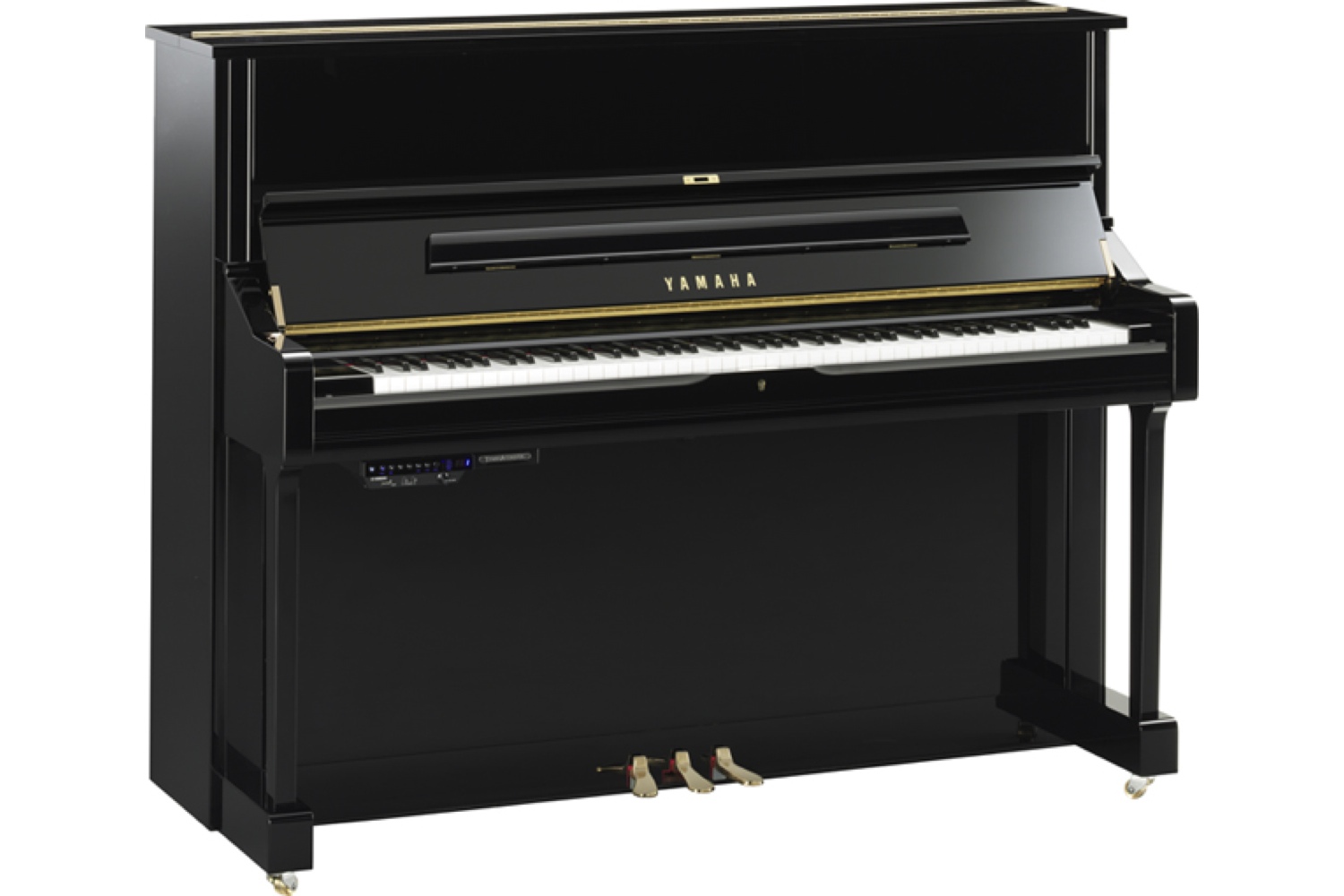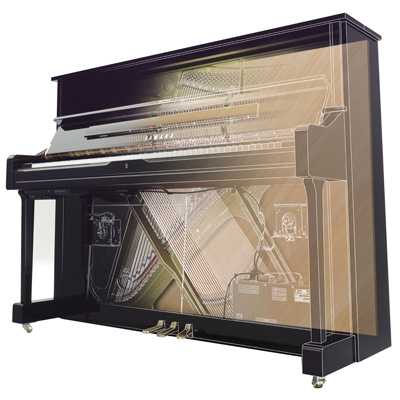
Imagine, however improbable this sounds, an electrified piano that didn’t use speakers to send music vibrating through the air — a device that required electricity to trigger its sampled sounds, but that didn’t have two or four or however many discrete sound-generating cones planted somewhere beneath the skin of its frame to conjure audible vibrations.
What if instead, the entire device were the speaker? Just as a fully acoustic piano’s soundboard amplifies the sound generated by the piano’s hammers striking strings, the electrified device could channel its digital samples through that same resonant slab of wood, in turn projecting the samples through the body of the instrument, aping the acoustic hammer-string paradigm by making the entire piano the sound source. What sort of name would you give this bizarre-sounding electroacoustic contraption?
Yamaha, which makes just such a device, settled on the name “TransAcoustic,” or “beyond acoustic.” That’s because it’s an acoustic piano with strings, but also a digital piano that can trigger samples — and if you like, a third thing that combines both and produces sounds you’ve never heard before. Yamaha unveiled it at NAMM 2013, demoed it again at the winter show in 2014, and it’s just now shipping. I had a chance to finally play one at King’s Keyboard House in Ann Arbor, Michigan this week.
Before we delve into the TransAcoustic, a few words about my current instrument, Yamaha’s AvantGrand N2, which I’ve written about before here and here. It’s something Yamaha calls a hybrid piano because it employs a full grand acoustic action that lives in the body of a quasi-upright (it looks like a grand, only with the strings, soundboard, cast iron plate and rim lopped off). The action differs from a full acoustic in one way: Instead of felt hammers, each key’s action terminates in a tiny device that emits something an optical sensor can read to gauge its travel velocity, triggering sampled sounds stored in memory.
Yamaha calls this system a “hybrid” as opposed to a digital piano, because unlike even the best digitals, which make significant compromises in the synthetic action to remain portable, the AvantGrand’s action is taken from one of Yamaha’s acoustic pianos — the C1 Conservatory Classic Collection — and slipped into the frame of the hybrid, where it triggers samples of an actual Yamaha CFIIIS grand played back through multiple speaker points strategically situated around the frame and which then resonate through the body of the device.
But the AvantGrand’s samples have a realism ceiling, however piano-like they seem. If you’re a pianist who’s played on full acoustics all your life, it’s not hard to spot the AvantGrand’s deficiencies, which I’d sum up as a kind of diminished presence — a resonant edge and spatial ubiquity that’s missing from the sound, especially when you’re hammering away at its lower registers. I love my AvantGrand, but it’s still a compromise, at least if we’re assuming pianistic fidelity remains the holy grail.

The TransAcoustic, though technically classed as part of Yamaha’s silent piano lineup (it’s not the company’s followup to the AvantGrand, but a sidewise move), tries to address this deficiency along with others by throwing the notion of fixed speaker points out the window and instead uses a fully acoustic upright soundboard to route the piano’s digital samples through the same channel that un-electrified hammers-on-strings would go.
Power up the TransAcoustic, put it in digital mode, crank up the volume and start playing, and the sounds you’ll hear are coming through the soundboard, conveyed by a pair of transducers located along the base of the device. And where the AvantGrand’s samples come from Yamaha’s venerable CFIIIS grand, the TransAcoustic’s are lifted from the company’s newer CFX series, launched in 2010. During my demo, Yamaha told me the samples were created especially for the TransAcoustic, so this isn’t an off-the-shelf CFX sound.
But the TransAcoustic is also, and perhaps foremost, a full acoustic upright: Yamaha categorizes it as the U1TA, a vamp on the company’s U1 SH upright nomenclature. The frame and action and internal logistics are the same as the U1 SH’s, only with the TA’s electroacoustic bits and bobs. By shifting the sostenuto (middle) pedal left or right with your foot, you can turn the U1TA’s silent mode on or off. In acoustic mode, it’s just an acoustic U1 SH, the hammers positioned to strike the piano’s very real strings. In silent mode, the hammers are lifted back so that they strike nothing, allowing you to play the sampled sounds through the transducers and soundboard (with volume control), or quietly through a pair of headphones.
So what happens if you leave the sampled sounds on while in acoustic mode? That’s where the TransAcoustic makes the strongest case for its existence. By themselves, the digital and acoustic modes are roughly on par with what you’d expect from a digital-only or acoustic-only device, and in that sense not as interesting. But pair the sampled sounds of the CFX grand with the U1TA in its acoustic hammers-on-strings mode — both sounds played simultaneously and intertwining through the piano soundboard and frame — and the result is something that sounds much more like a full grand than the AvantGrand’s samples-only approach.
Not precisely like a full grand, to be clear. It’s still an approximation, and there wasn’t a CFX nearby to fairly compare, so I was left approaching it from the perspective of an AvantGrand owner. The difference between what Yamaha’s doing with the AvantGrand and the TransAcoustic comes down to volume and sonic omni-directionality.
The TransAcoustic leverages its ability to jack up the CFX samples’ decibel levels against the fact that both the stringed and sampled sounds vibrate simultaneously through the same soundboard (Yamaha probably missed an opportunity to call this thing a TransFusion). I’d been expecting not to like the combined sound as much, or at least to prefer the acoustic-only one, but as I played the piano in TransAcoustic mode, turning the sample volume up or down to evaluate the CFX samples’ impact, I was surprised by just how much warmer and fuller the two together were. What’s more, my ability to control the sound, dynamically speaking, felt uncanny. I’m no great player, but shifting gears with the U1TA was almost too easy, and the dynamic palette felt broader than any upright I’ve played on before.
Okay, you’re saying, but what about tuning issues? What happens when the strings go off-pitch (as they invariably will) and you’re layering perfectly in-tune samples against out-of-tune acoustic sounds? I wasn’t able to test this, since the U1TA was in-tune, but Yamaha tells me it’s engineered a variety of ways to let you fiddle the samples so they’ll accommodate subtle frequency shifts in the acoustic’s temperament (you do this through the device’s console interface, which sits just below the key bed and to the left). And barring that, you can always put the piano in digital-only mode, playing the in-tune sampled sounds through the soundboard until you can get the device properly serviced.

What’s not entirely clear to me at this point is whom Yamaha intends the U1TA for. At $16,699 MSRP, it’s $2,000 more than the MSRP for the U1 SH (which already has the Silent Piano feature) and $1,700 more than my $14,999 AvantGrand N2 (note that no one pays MSRP or generally anywhere near those numbers after you’ve negotiated with a reasonable dealer, and I’m using them for comparison purposes only). The U1TA’s biggest advantage is its ability to project a very big, very realistic grand-esque sound from an upright’s body, true, but you’re restricted to an upright action, something that’s a deal-breaker for players like me who prefer a grand action’s responsiveness.
Yamaha says there’s a grand version of the TransAcoustic in the works for this fall, but we’re talking about a full-blown grand, thus I assume a significant price jump, and then there’s the question of why you’d need or want more projection from a piano intrinsically designed to produce enormous sounds on its own. A baby five-footer that can project like a concert nine-footer? We’ll see.
The argument, I suppose, is that the U1TA is now the most versatile of Yamaha’s digital/acoustic devices: It can be an unplugged upright acoustic. It can be a plugged-in silent piano (the binaural samples through headphones, by the way, have to be heard to be believed), a digital piano tapping a custom take on Yamaha’s high-end CFX grand — or any of its 19 other sounds, including electrics, organs, strings and so forth — routed through the acoustic’s soundboard, a hub you can route other sound sources into (say a smartphone), which then play through the transducers and soundboard as well. Or it can be this uncanny third thing; the confluence of acoustic and digital sounds, producing something new and resonant and surprisingly spacious when you consider it’s coming from the compact body of an upright, not a grand.
More Must-Reads from TIME
- Donald Trump Is TIME's 2024 Person of the Year
- Why We Chose Trump as Person of the Year
- Is Intermittent Fasting Good or Bad for You?
- The 100 Must-Read Books of 2024
- The 20 Best Christmas TV Episodes
- Column: If Optimism Feels Ridiculous Now, Try Hope
- The Future of Climate Action Is Trade Policy
- Merle Bombardieri Is Helping People Make the Baby Decision
Write to Matt Peckham at matt.peckham@time.com